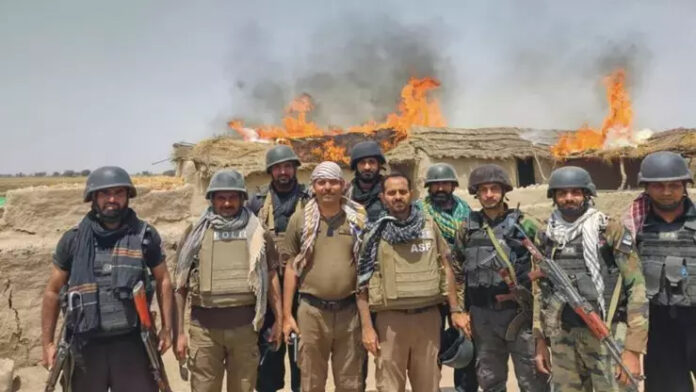In the bygone era, the dacoits of Sindh residing in its rural hinterlands, were renowned for their adherence to a code of conduct characterized by a peculiar sense of honour.
They demonstrated a propensity to target individuals of considerable financial means, refraining from preying upon the impoverished and downtrodden. Moreover, they exhibited a notable reverence towards women and abstained from causing undue harm or discomfort to the less fortunate. Regrettably, contemporary depictions of dacoits portray a stark departure from this erstwhile chivalrous archetype. Present-day accounts depict dacoits as harbouring a ruthless demeanour, often collaborating with local landlords and politically influential figures to perpetrate acts of heinous violence and unabated brutality, thereby eschewing the noble principles of yore.
The government must prioritize the safety and security of its citizens by taking strict actions against these criminals. Only through concerted efforts and comprehensive strategies can Sindh rid itself of this scourge and restore safety to its people. It’s time for the government to demonstrate its commitment to justice and security through meaningful actions and accountability. The last major anti-kidnapping operation took place in 1990, but it seems that the effect has long worn off. That operation was conducted by the Army. The Sindh government would do well to use its police and end this menace, before the federal government (which belongs to a different party) is forced to act and use federal froces, such as the Rangers and the Army
The recent surge in kidnappings for ransom has plunged the people of Sindh into a state of fear and uncertainty. With over 60 individuals becoming victims of such heartless dacoits this year alone, the crisis looms large, leaving a palpable sense of insecurity among the populace. The epicentre of this epidemic is the Kacho area of District Kashmore, particularly on the Kandhkot side, where criminal gangs operate with impunity, exploiting the vulnerabilities of the local population.
In a recent tragic incident in Ghouspur, Kandhkot district, Mohammad Rafique Samejo was abducted along with his colleague Javed Shaikh. Samejo met a tragic end, brutally tortured and dumped near the B.S. Feeder Canal, while Shaikh remains captive, amplifying the community’s distress and fueling anger against the ineffectiveness of the law enforcement agencies.
The modus operandi of these dacoits is both cunning and cruel, exploiting victims through tactics like “honey trapping” and false job opportunities. Ransom demands reach into the millions, imposing a heavy financial burden on victims and their families, often with dire consequences for those unable to pay. The psychological toll on families is immeasurable, exacerbated by the desperation of receiving ransom demands and gruesome videos, plunging them into a perpetual state of trauma and despair.
In response to the escalating kidnappings, Chief Minister Murad Ali Shah convened a cabinet meeting, acknowledging the gravity of the situation. Following a report from the Sindh police revealing 29 registered cases of kidnappings for ransom, the decision was made to launch operations against these dacoits. However, despite sporadic grand operations, the strongholds of these criminals remain intact, and they are helped by access to sophisticated weaponry and deep-rooted corruption within law enforcement agencies. Moreover, the situation has escalated to the point where almost half of northern Sindh is paralyzed by strikes and sit-in protests, persisting for over a week. The continuous abduction and kidnapping menace have driven hundreds to migrate, particularly targeting the Hindu communities, exacerbating ethnic tensions and social divisions within the region.
It is imperative for the government to take decisive action to combat this crisis. The authorities must address the root causes of these crimes by investigating and dismantling the networks responsible for supplying arms to these dacoits. Consistency in uprooting these criminals is essential, with Chief Minister Murad Ali Shah’s directives needing to be followed by concrete actions. A thorough investigation into the involvement of potential political patrons in arms trafficking is crucial.
Strengthening intelligence gathering, implementing strict penalties for arms trafficking, and providing support and protection for victims and their families are imperative steps. Additionally, enhancing community policing initiatives and investing in socio-economic development to address underlying factors are vital measures.
The dacoits do not seem to have updated their methods, and still keep their victims at patharis, which are run by patharidars, usually local influentials who feel themselves safe from raids to recover the victims. These patharidars usually charge a daily rent for the victims. They are also often the ones supplying arms to the kidnappers, and are involved in the illicit weapons trade.
The government must prioritize the safety and security of its citizens by taking strict actions against these criminals. Only through concerted efforts and comprehensive strategies can Sindh rid itself of this scourge and restore safety to its people. It’s time for the government to demonstrate its commitment to justice and security through meaningful actions and accountability.
The last major anti-kidnapping operation took place in 1990, but it seems that the effect has long worn off. That operation was conducted by the Army. The Sindh government would do well to use its police and end this menace, before the federal government (which belongs to a different party) is forced to act and use federal froces, such as the Rangers and the Army.






















